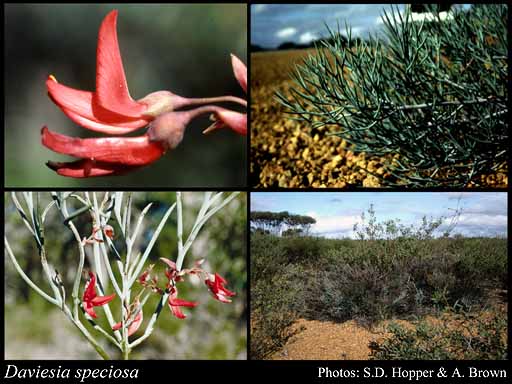- Reference
- Austral.Syst.Bot. 8:1237-1238,Fig.36 (1995)
- Conservation Code
-
Threatened
A taxon name retains its ‘Threatened’ status until a new name has been officially endorsed and appears in the Gazettal Notice.
- Naturalised Status
- Native to Western Australia
- Name Status
- Current
Many-stemmed shrub, 0.3-0.8 m high. Fl. red, Apr to May. Gravelly lateritic soils. Undulating plains, rises.







Scientific Description
Genus Daviesia. Form erect. Habit shrub, spindly shrub (broom-like). Stems Indumentum glabrous, Pustules or glands absent, Striation (stems ribbed) not striate, Cross section terete, Spiny on any part of plant spiny at least in part. Leaves or phylloclades Presence clearly present, Position alternate, Leaves or phylloclade continuous with stem not continuous with stem, Cross section of leaf or leaflet terete, Tuberculate tubercles absent, Pustules or glands absent. Length Leaf length 95-180. Width (entire leaves only) Leaf width NaN (?). Scale leaves length mm long NaN (?). Indumentum Presence glabrous. Stipules Presence apparently absent even from the youngest leaves, Glands with glands (?) or without glands (?), Ribs ribbed (?) or ribless (?). Length Stipule length NaN (?). Bracteoles Presence absent, Indumentum hairy (?) or glabrous (?), Striation striate (?) or not striate (?). Length Bracteole length NaN (?). Pedicel Presence present, Indumentum glabrous. Length Pedicel length 13-15. Calyx Pustules or glands absent, Ribs ribless, Enlarged in fruit not accrescent. Length Calyx length 6-7.5. Indumentum Presence glabrous. Corolla Colour patterning uniformly coloured, Colour (when uniformly coloured) red, Petal claws ( the narrow base of the petals present. Length Corolla length 20-23. Indumentum Presence absent. Standard Indumentum glabrous, Auricles not auriculate. Length Standard length 20-23. Wings Auricles not auriculate. Length Wing length 15-17. Keel Auricles not auriculate, Indumentum glabrous, Beak beaked. Length Keel length 15-18. Stamens Number ten. Anthers anther length 0.3-0.4, Position at two different levels (filaments alternately long and short). Filaments Fusion free (or united at the very base). Length Filament length 18-23. Ovary Placement sessile or subsessile. Indumentum Presence glabrous. Style Indumentum glabrous, Bearded ( with a tuft of hairs at apex ) not bearded, Apex terete. Length Style length 20-25. Fruit Type dehiscent (a pod or follicle), Constriction not constricted between the seeds, Compression flat or compressed, Placement sessile or subsessile, Beak beaked. Length Fruit length NaN (?). Width Fruit width NaN (?). Indumentum Presence hairy (?) or glabrous (?), Indumentum type with simple hairs (?) or with glandular hairs (?). Flowering time April or May. Distribution Botanical Province South-West, IBRA Bioregion Geraldton Sandplains or Avon Wheatbelt. Conservation Code Threatened (T).
Distribution
- IBRA Regions
- Avon Wheatbelt, Geraldton Sandplains, Mallee.
- IBRA Subregions
- Eastern Mallee, Lesueur Sandplain, Merredin.
- Local Government Areas (LGAs)
- Carnamah, Esperance, Irwin, Mingenew, Three Springs.